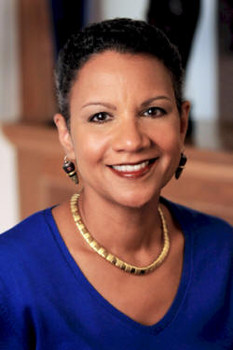 MEET A’Lelia Bundles: A’Lelia Bundles is an author, journalist, public speaker and member of several non-profit boards. Her biography of her great-great-grandmother, On Her Own Ground: The Life and Times of Madam C. J. Walker, was named a New York Times Notable Book. During a 30 year career as a producer with NBC News and ABC News, she received an Emmy Award and served as Washington, DC deputy bureau chief for ABC News. Her articles have appeared in the New York Times, O (The Oprah Magazine), Essence and Fortune Small Business. She is president and chairman of the board of the Foundation for the National Archives and a vice chair of Columbia University’s Board of Trustees. A graduate of Harvard College and of the Columbia University Graduate School of Journalism, A’Lelia lives in Washington, DC and can be reached at www.aleliabundles.com.
MEET A’Lelia Bundles: A’Lelia Bundles is an author, journalist, public speaker and member of several non-profit boards. Her biography of her great-great-grandmother, On Her Own Ground: The Life and Times of Madam C. J. Walker, was named a New York Times Notable Book. During a 30 year career as a producer with NBC News and ABC News, she received an Emmy Award and served as Washington, DC deputy bureau chief for ABC News. Her articles have appeared in the New York Times, O (The Oprah Magazine), Essence and Fortune Small Business. She is president and chairman of the board of the Foundation for the National Archives and a vice chair of Columbia University’s Board of Trustees. A graduate of Harvard College and of the Columbia University Graduate School of Journalism, A’Lelia lives in Washington, DC and can be reached at www.aleliabundles.com.
WMI: What was early life like for your great-great grandmother, Sarah Breedlove (who became Madam C. J. Walker)?
AB: When Sarah Breedlove was born in 1867 on the same Delta, Louisiana plantation where her parents had been enslaved, there was no way to predict that she would one day become Madam C. J. Walker, a millionaire entrepreneur. Her early life was filled with what could have been insurmountable obstacles. She was orphaned at seven, abused by a brother-in-law as an adolescent, married at 14, a mother at 17 and a widow at 20, with very little formal education. Fortunately she was able to move in the late 1880s to St. Louis, where she had three brothers who were barbers and who were willing to help her start a new life.
WMI: Did you get the chance to meet your famous great-great grandmother? If so, what were those times, spent with her, like?
AB: No, my great-great-grandmother died in 1919 so I never met her, but I grew up in a house surrounded by things that had belonged to her, and, for more than four decades, I have studied her life. The silverware that we used every day, and the china we used on holidays, belonged to Madam Walker. My grandfather saved letters, photographs, clothing, furniture and other memorabilia that now are part of our Madam Walker Family Archives. While doing research for three biographies, including On Her Own Ground: The Life and Times of Madam C. J. Walker, I visited libraries, courthouses and historical societies in more than a dozen cities. During the 1970s and 1980s I was able to interview people who had known Madam Walker and my great-grandmother, A’Lelia Walker, whose parties helped define the Harlem Renaissance. Now as I am writing a biography of A’Lelia Walker, I am revisiting that early research and adding to what I already knew with hundreds of additional newspaper articles, letters and books. So while I never had a chance to have a conversation with Madam Walker, I “know” her perhaps better than most grandchildren know their grandmothers.
WMI: Madam C. J. Walker is the United State’s first self-made woman millionaire. What was it about her that drove her to overcome significant financial, gender and social odds to, not only start her own business, but to push her business to become one of the country’s most successful hair companies?
AB: There is no one person or experience that spurred Sarah Breedlove to overcome all the obstacles she faced. As with all of us, there are many factors that contributed to her success. Perhaps first and foremost, she was resilient and determined. Rather than being defeated by the early hardship she faced, she made up her mind that she would survive.
I believe her family minister, who even during the 1870s was a political leader and Louisiana state senator, inspired her brothers to leave Louisiana to seek a better life in St. Louis. In turn, she followed her brothers to Missouri where she joined St. Paul AME Church and was influenced by women of the church, who were teachers and community leaders. These middle class women helped her see that she and her daughter could benefit from education. She followed their example and began to have a vision of herself as something other than an uneducated washerwoman. The work her brothers did as barbers exposed her to the notion of hair care as a career.
Once she began to become successful in her business, she began to see the sales of hair care products as a means to an end to empower other women. She realized by helping them become economically independent she could do much more than change a hair style. In fact, she could help them improve life for themselves, their families and their communities. Her motivation was, as she said, not just to make money for herself, but to help others.
In 1917, the year before Mary Kay was born, Madam Walker held her first convention of her Walker sales agents in Philadelphia. At the convention she gave prizes to the women who had sold the most products. But she also gave prizes to the women who had contributed the most to charity. At the end of the convention, the women sent a telegram to President Woodrow Wilson urging him to support legislation to make lynching a federal crime. It was Madam Walker’s desire to use her wealth and influence to make life better for women and African Americans that motivated her to see her goal as much more than the sale of hair care products.
Of course, it is incredible and laudable that Madam Walker became a millionaire, but for me, she is even more worth being praised and remembered because she used her wealth and influence as a philanthropist who supported educational institutions and community organizations; a political activist who contributed to the anti-lynching movement; a patron of culture, who supported black musicians, artists and actors; and an entrepreneur who provided jobs for thousands of African American women.
WMI: Have you ever thought about managing your great-great grandmother’s business or has it always been your ambition to be a journalist/book author?
AB: My passion always has been writing. Both my parents were hair care company executives: my mother, A’Lelia Mae Perry Bundles, was vice president of the Madam C. J. Walker Manufacturing Company, and my father was president of Summit Laboratories. As a result, I have had a long time fascination with the industry and have a great deal of admiration for the women and men who continue to bring innovative and visionary ideas to the business.
By the late 1960s, Summit Labs was a much more successful player in black hair care circles than the Walker Company, which really had had its heyday from 1910 through 1960. Fortunately, my parents were wise enough to encourage me to follow my own dreams, just as they had followed theirs and just as Madam Walker had followed hers. I’m convinced that if I had felt obligated to do something other than my passion, I would not have made the contribution to keeping Madam Walker’s legacy alive in ways that I think carry her story to a much wider audience. By spearheading the campaign for a Madam Walker stamp in 1998, by writing a bestselling biography about her, by making dozens of speeches a year, by creating a website that is visited by thousands of students each year, by serving on the board of the Madam Walker Theater Center and by sharing research and photos of her through my Madam Walker Family Archives, I think I’ve done more to help others know about her than I would have had I not developed my skills as a journalist and scholar. I think each generation needs to build on the success of the previous generation. Sometimes branching out and doing something different is the best way to further the legacy.
Here’s a link to our official Madam C. J. Walker website: www.madamcjwalker.com and a link to some of my video interviews about Madam Walker http://www.aleliabundles.com/2013/02/01/madam-walker-black-history-month-2013-day-1/ so you can see how our family celebrates Madam Walker’s life.
I love seeing today’s truly successful hair care and cosmetics entrepreneurs like Titi and Miko Branch of Miss Jessie’s and Lisa Price of Carol’s Daughter, people who have taken Madam Walker’s model to a new level and managed to remain at the top of a very competitive industry. I also am thrilled to see women like Marie Johns, Deputy Administrator of the Small Business Administration; Ursula Burns, CEO of Xerox and Deborah Lee, CEO of BET, who set examples for all of us with their accomplishments in business and in community involvement.
WMI: How do you think your great-great grandmother would fare into today’s competitive beauty industry?
AB: My guess is that Madam Walker would have found ways to be a leader in today’s competitive beauty industry. Of course, the hair care business is quite different on so many levels, but some things remain the same. She understood the importance of a high quality product, talented employees, strong marketing and advertising, associating with positive people and working for the greater good.
I have to imagine that she would have a top notch research and development department to help her adapt her products to include more moisturizers as an improvement on the heavy ointments that were popular a century ago. She’d use the same instincts that made her advertising and marketing so successful in the early 1900s and adapt to today’s social media opportunities. I also would imagine that she’d be a leading philanthropist, contributing to political causes, the arts and educational institutions.
Madam Walker’s business was successful, in part, because of her personal charisma and leadership. Some of her competitors had products with similar ingredients and formulas, but it was her marketing genius, her entrepreneurial vision, her ability to execute that vision and her knack for hiring and motivating talented employees that made her so successful. She provided ongoing training and education for her sales agents by creating an infrastructure that enabled their growth and development. She understood that the products alone are not enough. The CEO and the team have to be up to the task.
WMI: Describe the media scene/atmosphere when you launched your journalism career.
AB: Journalism has changed and changed again and changed again since I had my first byline at 8 years old. When I became editor of my junior high school newspaper in the 1960s, we wrote our articles on typewriters and text was still set on printing presses! When I went to work at NBC News in the mid-1970s, our camera crews were just beginning to switch from film to reel-to-reel videotape! At the time women and people of color were finally being hired as producers and reporters in network television and at local stations. In fact, there were only four national networks—ABC, NBC, CBS and PBS. Cable television, the Internet, iPads, smart phones, computers , Facebook, Twitter and the dozens of ways to create and distribute information that we now take for granted just didn’t exist!
WMI: How has the journalism field changed since those early days, both the good and the undesirable?
AB: The industry has changed in inconceivable ways. The business model that worked for newspapers, magazines and television networks doesn’t work anymore and is being entirely revamped.
On the one hand, there have never been so many opportunities for us to tell our stories since anyone with a computer and access to the Internet can start a blog, host a radio show or make a video. On the other hand, there still are not enough women and people of color in positions of power and responsibility in the nation’s newsrooms, Hollywood studios and other editorial offices. And there is a lot of junk and misinformation being disseminated by people whose work is not being vetted and edited.
The person who has a vision of how to maintain high quality, accurate journalism while reaching large numbers of people at a profit will help the industry survive.
WMI: You’ve worked with some heavy hitters, Peter Jennings, Connie Chung and Tom Brokaw, to name a few. What did you learn from these media giants that you continue to benefit from today?
AB: I was fortunate to work in network television news during the era when people like David Brinkley, Tom Brokaw, Ted Koppel and Peter Jennings were the leading anchors. During the 1970s, 1980s and 1990s when I worked for NBC News and ABC News, most Americans got their daily national and international news from those networks as well as from CBS and PBS. In addition to observing how important good research and careful fact-checking were to the integrity of those news operations, I learned as much or more from the people behind the scenes: the executive producers, the correspondents, the editors, the seasoned camera crews and the other producers with whom I worked. Television news is a very collaborative endeavor. While the “big names” are known by the public, the finished product requires the talents of many people.
The skills and lessons I learned from all of my colleagues—about storytelling, researching, investigative reporting, consulting multiple sources, having a healthy skepticism, selecting compelling video and photographs, identifying great characters—continue to benefit me as I write books and make speeches.
WMI: Media controls much of human perception, especially in areas where people watch 5 or more hours of television (online or offline) a day. Do you think it’s important to, not only present a balanced perspective of news, but to also have a balanced cultural representation of newscasters or anchors? Why or why not?
AB: Yes, of course it’s important to present a balanced perspective and to have diversity among reporters and anchors. When any news organization represents only one perspective—and in fact misrepresents and obscures the facts—they are doing a disservice to their viewers, listeners and readers. Today, of course, the audience is much more politically and ideologically segmented and many people listen only to news with a perspective with which they agree.
I have to say that while there is a responsibility on the part of individual news organizations to present a balanced perspective, we all must take personal responsibility for seeking a wide range of sources for our news. I start my day listening to “Morning Edition” on NPR because I want to know what is going on in the realm of politics, economics, culture and world events. I read several newspapers and magazines. To that I’ve added several blogs and websites. I often see breaking news first on Facebook because many of my Facebook friends are journalists.
We also must go the original source and not just read the information that has been interpreted for us. For example, during the presidential campaign, I was very interested in being informed about Republican efforts to suppress the vote. I followed the story in newspapers, on radio, on television and on many websites, but I also read the original reports that were written by scholars and political analysts.
WMI: What can we do to encourage more African American youth to pursue television journalism?
AB: Encouraging more young people to become interested in careers really starts at home and in school. One way might be to incorporate journalism into history and social studies curricula. All students should have guidance on how to evaluate the news and to see that MSNBC, Fox News, NPR, Jon Stewart, PBS, etc. can take the same story and present it in different ways. “Journalism literacy” is an important skill. Most major cities have chapters of the National Association of Black Journalists and many of those chapters host career days. Journalists also can be invited to classes to speak with students.
The truth is, I’d really rather encourage them to become executive producers, managers, editors and owners than reporters and anchors. We need to encourage our young people not to be drawn in by the superficial celebrity aspects of television. It is the owners and executives who make the decisions. I’d rather we encourage them to become engineers who develop the technology and apps and software that controls the distribution of the content than encourage them to become celebrities who read the news.
WMI: A’Lelia, how in the world did you find the time to juggle working as a producer with ABC News, later NBC News while you wrote your books, Madam C. J. Walker: Entrepreneur and On Her Own Ground: The Life and Times of Madam C. J. Walker?
AB: No special magic. I love what I do and I work hard. There’s always so much more to do! These days I really enjoy all the platforms that allow me to share Madam Walker’s story and that allow me to express my passion for journalism and current events.
Here’s a link to my website: www.aleliabundles.com
I also have several Facebook pages on a range of topics including culture, history, hair and Madam Walker. We now have more than 8,000 followers on our various Facebook pages. Here are links to a few of them:
- Black Hair Historian https://www.facebook.com/pages/Black-Hair-Historian-ALelia-Bundles/219494064767533?fref=ts
- A’Lelia Bundles/Author Page https://www.facebook.com/AleliaBundles.Author?fref=ts
- Helping Ourselves/Black History & Culture https://www.facebook.com/pages/Helping-Ourselves/124115357685135?fref=ts
- Madam Walker Biography https://www.facebook.com/MadamCJWalkerOfficialBiography?fref=ts
- Madam Walker Family Archives https://www.facebook.com/MadamWalkerandAleliaWalkerFamilyArchives?fref=ts
WMI: Share two to three experiences you had with readers who reached out to you, letting you know how your books encouraged them to pursue their own business dreams?
AB: It’s always great to hear from people who tell me my books about Madam Walker have encouraged them to start a business or to keep going when they’ve been frustrated.
What I love about being Madam Walker’s biographer is that her story inspires such a wide range of people. I’ve spoken to women who are incarcerated at the Bedford Hills Correctional Facility and who had written reports about Madam Walker as well as to students at the Harvard Business School who were studying her business model.
Cathy Hughes, the founder of Radio One, often mentions Madam Walker as a source of inspiration, as do Titi and Miko Branch of Miss Jessie’s and Susan Taylor, who was the editor-in-chief of Essence for many years. And, of course, I hear from dozens of students each year who are writing reports about Madam Walker.
WMI: Tell us about some of the services/programs offered through the Madam Walker Theatre Center.
AB: Today the Madam Walker Theatre Center, a National Historic Landmark in Indianapolis, hosts the best of African American culture through music, theater and lectures, from jazz and gospel to opera and hip hop. Among the recent performers are Savion Glover, Patti LaBelle, Smokey Robinson and Michael Bolton. During the summers, students are exposed to music, dance and theater arts.
I remain a supporter of the work of the Walker Theatre as well as Villa Lewaro, Madam Walker’s Irvington, New York mansion, which also is a National Historic Landmark. You can learn more about the MWTC and Villa Lewaro at www.walkertheatre.com and www.madamwalkerestate.com
WMI: You’re on the board of the Foundation for National Archives. What are three to four major initiatives the Foundation plans for 2013?
AB: I became president and chairman of the board of the Foundation for the National Archives in January 2012. As the private partner of the National Archives and Records Administration—the federal agency that houses all government documents ranging from census records and presidential papers to veterans records and Congressional materials—we raise funds and support exhibitions, lectures and publications to help make these documents more accessible to the American public. Our goal is to increase civic literacy.
We were proud to help sponsor the very special viewing of President Abraham Lincoln’s original, handwritten Emancipation Proclamation earlier this year to celebrate the 150th anniversary of this document. Since January we’ve already helped the Archives host events with Annette Gordon-Reed, Deborah Willis, Barbara Krauthamer, Eric Foner and many other scholars. The Archives currently is featuring documents related to Rosa Parks’s arrest in honor of her 100th birthday.
Throughout this year, the Archives will be featuring several documents related to the 1963 March on Washington and other 50th anniversary civil rights events. In November, we’ll be opening a second permanent gallery featuring federal documents that tell the story of civil rights, women’s rights and immigration. Of course, every day of the year, visitors come to see the Declaration of Independence, the Constitution and the Bill of Rights. Here’s a link to the keynote address I delivered at the National Archives on July 4, 2012. https://www.youtube.com/watch?v=M7LdN4d4t1g
WMI: What’s next for A’Lelia Bundles? Where do you see yourself three to five years from now?
AB: I’m busy finishing the manuscript for Joy Goddess: A’Lelia Walker and the Harlem Renaissance. I’m very excited about this book, which will finally tell the story of my great-grandmother, who was a central figure of the Harlem Renaissance. She’s often mentioned in books about New York in the 1920s, but I think readers will be surprised at the impact she had on the cultural scene and what an interesting life she lived, not just as Madam Walker’s daughter, but in her own right.
Here’s an article based on one of the chapters in the book. http://www.aleliabundles.com/2011/12/01/my-grandmothers-harlem-renaissance-wedding/
Once that project is completed, I’ll be looking for my next adventure and will continue to serve on the Foundation for the National Archives board as well as on Columbia University’s board of trustees, the Schlesinger Library’s Advisory Council, the Woodlawn Conservancy and the Indiana Historical Society’s Publications Committee.
If you enjoyed or benefitted from this article, share it with others by clicking the Twitter, Facebook, LinkedIn, Google Plus and Share buttons below. You bet! We appreciate it!
Click the “Subscribe” button at the side or bottom of this post so you can always be the very first person to receive our updates!
Get Your Copy of Love Pour Over Me at http://www.amazon.com/Love-Pour-Over-Me-ebook/dp/B007MC0Z2C




You must be logged in to post a comment.